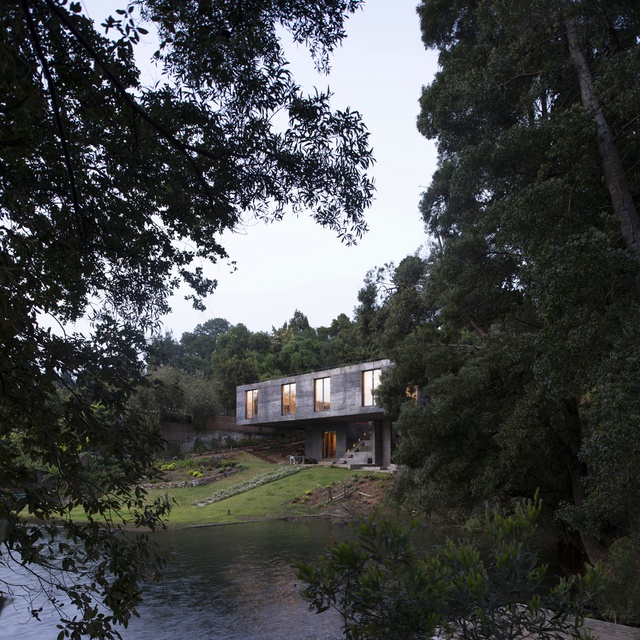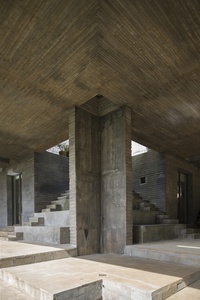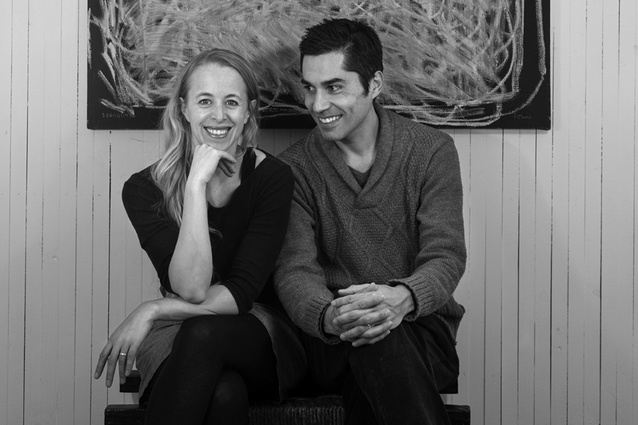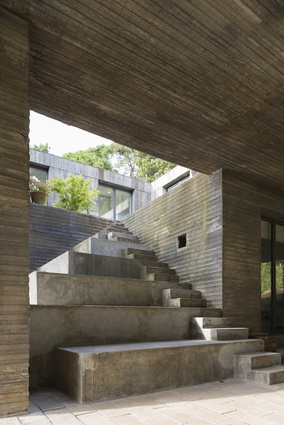Interview: Pezo von Ellrichshausen
Aaron Paterson of PAC talks to Chilean architects Mauricio Pezo and Sofia von Ellrichshausen from Pezo von Ellrichshausen about some of their creations, and the state of building in their region.
Aaron Paterson: Chilean architects, like yourself, Smiljan Radic and Alejandro Aravena, have all in different ways progressed contemporary architecture. What are your thoughts on the architectural culture of Chile?
Sofia von Ellrichshausen: I think it is indeed in a healthy moment, yet not so much due to the exclusive impact of those exceptional cases but more because of a rather stable growth and improvement of the average production of architecture. We like to think that a national scene can be described by the figure of a drop. There are very few really original-thinking practitioners at the top of the figure. The large group of practitioners occupies the transition from the lowest extreme, from that vast majority of poor architecture.
In an ideal world, one would dream with a double pointed fat drop, with the presence of as few extraordinary architects as bad ones. I believe the relevant cultural substratum resides in the middle ground, in the production of good buildings without being exceptional, which is precisely what makes exceptional urban or rural landscapes.
AP: Cristián Undurraga said… “If there’s an aspect that you can recognize as Chilean, it’s the way architects work with materials. It’s very direct. It’s simple.” Does this quote resonate with you?
Mauricio Pezo: I think there is a commonplace equivalent to say that the value of Chilean architecture lies in the geography in which it is located. Nonsense. There are simple materials everywhere, as much as there is geography everywhere. That is to mix conditions with consequences.
In fact I do not believe in the notion of “Chilean” as a valid category to define the production of buildings that takes place in Chile. A geopolitical distinction does not imply any intrinsic architectonic value. Of course there are several corporate architects who are trying to label themselves with the features the international media wants to read in the production of a particular region.

Perhaps this is a new form of “a-critical regionalism”. I guess it is a popular slogan because it is good business, a kind of communicational fast track, from the two sides; from those architects who try to export what they do and from a superficial media that only copies and pastes what they receive, without further consideration.
SVE: It is hard to agree with such a general note. Of course architects, at least those interested in translating ideas into physical constructions, have to inevitably deal with the material aspect of reality. But architecture is by definition a pragmatic art, so I suppose the directness, a possible roughness, as much as the feeling or the economy of the materials are transversal problems of our practice.
AP: You work with raw concrete a lot. It is a very direct material and suits the simple and monumental forms you create. What are the qualities of concrete that keep you interested?
SVE: A fundamental quality is its capacity to neutralise, as much as possible, the mysterious and unpredictable seismic forces. This is a real fact for us. We practice under the understanding that, as David Leatherbarrow once beautifully wrote, we make “buildings that last for places that may not”.
If that force is monumental, or sublime but insanely devastating, I presume its counterbalance should be equivalent. This counts, without any stylistic or moral distinction, for any wall or column we have built and for all those we hope to continue building. It is not only the character of the mass or the impressions on the surfaces that we appreciate, but that sense of rest, of inertia, a kind of embodied sense of nature.
AP: The Guna house (featured in the April-May 2016 issue of Urbis) is a contemporary take on the historical precedents of an elevated rotunda in the landscape and the piano nobile. Were these typologies in your mind when you designed the house?
MP: We assume the production of a new building as what it is; as the naïve attempt of inventing an original artefact, of bringing something new to our known world. Therefore, we have been explicit about our refusal to use any reference for what we do. While producing a project, we do not refer to precedents, to images, to concepts, to history, etc. In our internal enquiries we are trying to define a self-referential system of spatial relationships, or what we call the spatial structure of a building.
There is an undeniable culture that infiltrates in what we see, in what we think and make. But that is no more than a general background, an intellectual substratum, a kind of soft memory, a memory that in our case is much more connected with the art world. When thinking a building we assume a voluntary blindness, similar to a “docta ignorantia”.

In fact, that notion of an elevated rotunda is an invention. Up to a certain extent, it is an element you can find in some buildings, some Renaissance villas for instance. But we are not referring to that kind of podium, the one anchored in the ground. We are highlighting the fact that there is a fairly unique relationship: there is a patio separated from the ground and surrounded by rooms floating in the air. This is a difficult problem – how to make a room with an exterior in four sides of its section. The answer, to touch its supporting podium in a single corner, is the evolution of a previous house we built in Spain some years ago, but not before then.
AP: You seem to be interested in rigorous geometries and deliberate circulation, what has ignited your interest in a formally pure architecture?
SVE: We have never thought about what we do as an attempt for the so-called pure forms. We are interested in clear definition of formal qualities, such as proportion, size or spatial sequences. In our view, the rigour should happen in the relationships that form could promote; in the tensions, movements, in the sensual experience of a place as much as in the mental image we have about those relationships.
If there is a deliberate circulation, or a deliberate access or staircase, it is because there is a need for a particular spatial relationship. Sometimes that tension implies a degree of friction or even discomfort. We don’t have any moral problem about it; we believe the excess of functionalism ends up eroding the potential for unpredictable situations given by the very complexity of life.
AP: The Guna house is composed as a series of 12 repetitive square volumes around a courtyard and central circulation. It is very rigid planning. Do domestic functions have to bend to fit into your plans?
SVE: Yes and no; the correspondence between form and function is always relative to the situation. There seems to be an inherited modernist misunderstanding about this matter. Besides that myth, Guna has a very precise arrangement of domestic activities according to the cardinal orientation and to the picturesque natural landscape, but it doesn’t really have volumes.
It is an interconnected sequence of rooms, a ring with crossed extensions and a patio without a quarter of its floor. The daily functions unfold in two opposite corners, in a perimeter, with different degrees of intimacy. It is a lifestyle that ends up diluting any notion of formality or geometrical severity.
AP: How rigid a design is too rigid for the domestic setting? How does this house allow for spontaneity of life? Or is this house a backdrop to life?

MP: As Sofia mentioned, the house is strictly formed by rooms directly conceived for certain uses and not others. Even if the same size and proportion of each of those rooms could be used for another activity, in this case, they are meant to remain performing the same original function; as bed, bath, dining or living rooms. Anyhow, you could also understand the house according to its double stratification.
It is a monolithic piece composed by two very distinctive parts: a podium and a platform. This vertical difference establishes two opposite relationships with the terrain: one floating and the other sinking into it. The lower stratum promotes an informal extension to the garden, under the massive cantilever of the platform, and beyond to the lagoon shore. I think this is a domestic realm precisely calibrated for the family of five members who live there, a family with the confident prospect to live there as long as they can.
AP: The exterior is fort-like, but the interior is soft with sunlight on the painted rusticated pine board. This is a very deliberate move by you. Can you describe how you bring warmth into a concrete mass?
SVE: I believe the meaning or perception of that opposition between the exterior and interior surfaces is extremely relative. In fact, my feeling is that the rough horizontal texture of the concrete is at the same time very soft and almost transparent in reference to the dark green surrounding vegetation. Inside, the temperature is given by an array of soft greys and a pale travertine pavement throughout the entire house, without distinction of programme. But this is also very unstable, sometimes cold or more saturated, since it reacts with the natural light coming from an almost exaggerated amount of skylights.
AP: The Guna house looks like it could have been an old monument that has been repurposed. Do you think the house would make a splendid ruin?
MP: The very notion of a ruin implies a degree of defeat. It is nature gaining back its domain from artificial human endeavours. I agree with that idea. I suppose that is the inevitable destiny of every work of architecture; to be eroded by natural forces up to the point of total disappearance. The middle point in that unavoidable trajectory is the ruin itself. Not only as a moment of decay but as a sort of reconciliation between the two implicit forces: the natural and the human, one vector pulling down and the other up.

The other notion you mention, the old monument, somehow reinforces the idea of the ruin. The house can be understood as a monumental object, as a plinth that refers to itself, that occupies a unique place in a corner of the landscape. In a way, the deliberate imperfect appearance of the concrete surfaces have the capacity to makes us wonder about something else. It embodies a sense of memory, of resemblance to another time. This might be read as a veiled function of the house, of a monumental domesticity.
AP: The house repeats one window type throughout. Why did you choose the floor to ceiling rectangular windows?
SVE: There are many technical aspects, such as the possibility of hiding the sliding glass panels into the walls, in between the concrete and the wooden walls, to turn the interior into a semi-exterior space, like a covered belvedere. In the suspended platform, there are twenty-four windows in proportion 2:1 and thirty-three skylights in proportion 1:1.
We usually employ these basic proportions to convey a sense of familiarity and normality. With these rather traditional openings, we are interested in allowing an experience from within that tends to forget about the singularity of the opening in itself in order to focus your eyes, and also your mind, on what is beyond, in all of that which architecture is not.














